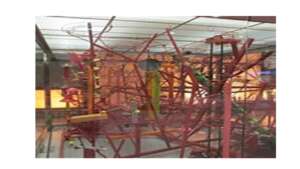
Learning into the Present II: Operating Complex Systems
Then there is the matter of motivation and boredom. How do you make the rolling of the ball down a single pathway somehow interesting. We can try making the pathway more complex and filled with many side effects – such as is the case with a famous kinetic art sculpture located at the Logan Airport in Boston Massachusetts. Called the “Goldberg Variation” this sculpture sends a set of balls down a metal pathway one at a time. While traveling along this one, well-protected pathway, the ball hits a set of gongs and belles, drops off a short cliff to the next edition of the pathway, and swirls around quite a bit on its journey to the bottom of the sculpture – only to be lifted again by a small elevator to the top of the sculpture. The process is repeated.
 It is a wonderful sculpture to witness–with many balls moving at the same time and many bells and gongs sounding at the same time. Yet even this compelling experience draws us in for only a short period of time. We must catch our flight to Chicago or pick up members of our family who have just arrived from San Francisco. Short-term novelty can hold our attention for only a short period of time—especially if this novelty is actually carefully controlled and predictable. It is only novel for a short period of time—and then it is “the same old thing again.”
It is a wonderful sculpture to witness–with many balls moving at the same time and many bells and gongs sounding at the same time. Yet even this compelling experience draws us in for only a short period of time. We must catch our flight to Chicago or pick up members of our family who have just arrived from San Francisco. Short-term novelty can hold our attention for only a short period of time—especially if this novelty is actually carefully controlled and predictable. It is only novel for a short period of time—and then it is “the same old thing again.”
What does all of this mean with regard to the functioning of frozen middle managers and middle management teams? First, it means that not much learning is taking place. There is what Gregory Bateson (2000) calls first-order learning. This elementary form of learning occurs when managers are first embarking on the journey down a predictable and restricted pathway. Inserting a fixed, first-order silo into healthcare results in a lowering of any higher order learning and thinking–what Bateson calls second-order learning and what Daniel Kahneman (2011) identifies as “slow thinking. Unfortunately, second order learning and related second order slow thinking are required when making dynamic adaptations to unique challenges and events. Rather than lifting up excellence of service on behalf of meeting an exceptional health care challenge, first order learning and habitual fast thinking can bring down the value of the most skilled professions when they are providing care under exceptional circumstances.
It is another matter when the health care provider faces the routine—when the balls are rolling down the restricted pathway. Once the managers have “learned the ropes” regarding this one project and one pathway, there is no need to learn anything more. Second-order learning is only needed when the ball (project) can move over a ridge (leaping out of an organizational silo) and venture into a new valley and learn how to navigate a new pathway. There is a side benefit: with this new challenge and new learning comes another level of learning. The unfrozen middle managers learn something about how to learn! Second-order learning is fully present. Rather than over-compensating for professional care variability with rigid, artificial siloed pathways, middle managers can carefully seek a full understanding of the complex, dynamic system in which they are operating. They can learn to coach and guide clinicians in seeking to limit unnecessary variability. As slow, analytic thinkers, these managers can ensure that the clinician’s autonomy is protected, while collaborating with the clinicians in arriving at thoughtful judgements—those required to navigate a warped plane of care in an adaptive and effective manner.
- Posted by Bill Bergquist
- On March 19, 2024
- 0 Comment



Leave Reply